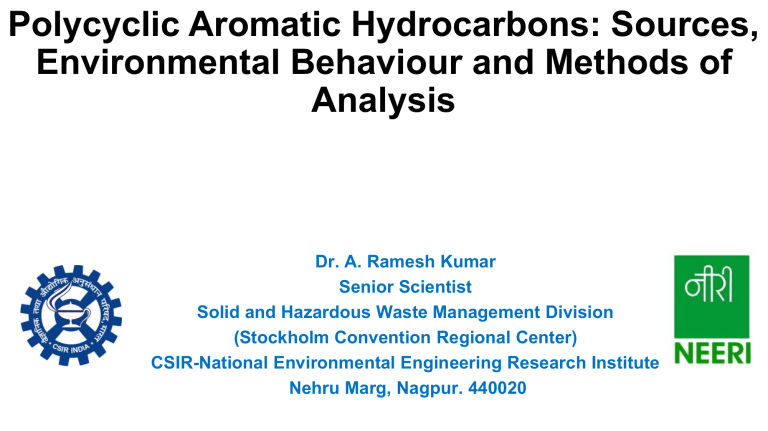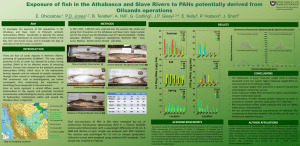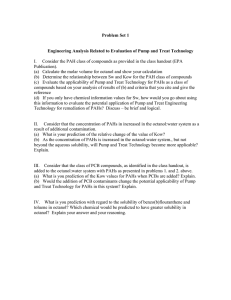
Polycyclic Aromatic Hydrocarbons: Sources, Environmental Behaviour and Methods of Analysis Dr. A. Ramesh Kumar Senior Scientist Solid and Hazardous Waste Management Division (Stockholm Convention Regional Center) CSIR-National Environmental Engineering Research Institute Nehru Marg, Nagpur. 440020 Scope 1. What are polycyclic aromatic hydrocarbons? 2. Sources, physico-chemical properties and environmental behaviour 4. Analysis by HPLC 5. Questions 2 What are polycyclic aromatic hydrocarbons? • Aromatic compounds with 2 or more fused/condensed ring • Thousands of PAHs are identified • Plannar molecules Naphthalene • Dense π electrons is responsible for the persistence of PAHs • Low water solubility, low vapor pressure, and high melting and boiling points • PAHs high molecular weight decrease water solubility and increase lipophilicity, making them more recalcitrant Anthracene Fluorene • Based on occurrence, recalcitrant nature, and toxicity, US EPA classified 16 PAHs as priority pollutants 3 Phenanthrene What is the concern ? • Ubiquitously present in the environment • Present at higher concentrations than other organic contaminants • Continuous emission from various sources • Known carcinogens (Group I and Group IIA & IIB) mutagenic, and teratogenic potencies • Associated with various adverse health effects • Non-dietary ingestion is an important pathway for human exposure • PAHs are formed during some methods of cooking 4 PAHs formation during Cooking of Food • PAHs formed by the incomplete burning of organic matter at temperatures over 200 C • Method of cooking • Grilling • Barbeque, smoking • Roasting • Tandoor PAH formation is influenced by: 1. Temperature of cooking 2. Duration of cooking 3. Type of fuel used in heating 4. Distance from heat source 5. Fat content of the food EU limit for BaP Oils and fats 2 μg/kg, foods for infants/ children 1 μg/kg; smoked meat and smoked fish 5 μg/kg; unsmoked fish 2 μg/kg FSSAI limit of BaP 5 µg/kg 6 How do we get exposed to PAHs? • Breathing air containing PAHs in the workplace of coking, coal-tar, and asphalt production plants; smokehouses; and municipal trash incineration facilities. • Breathing air from cigarette smoke, wood smoke, vehicle exhausts, asphalt roads, or agricultural burn smoke. • Coming in contact with air, water, or soil near hazardous waste sites. • Eating grilled or charred meats; contaminated cereals, flour, bread, vegetables, fruits, meats; and processed or pickled foods. • Drinking contaminated water or milk. • Nursing infants of mothers living near hazardous waste sites may be exposed to PAHs through their mother's milk. Polycyclic Aromatic Hydrocarbons: Sources • Incomplete pyrolytic/combustion process • Processing of coal, crude oil, burning of fossil fuels • Thermal power plants, cement industries, steel a production etc. • Biomass/wood burning • Vehicular exhaust • Waste incineration • High temperature cooking • Natural sources- forest fires, volcanic eruptions, petroleum products 8 Petrogenic PAHs • A typical crude oil may contain from 0.2 to more than 7% total PAH • Most of the PAHs in petroleum are low molecular weight hydrocarbons containing two or three fused aromatic rings e.g. naphthalene, anthracene, phenanthrene • Higher molecular weight PAHs, usually are at low concentrations (<100 ppm) • Petrol contains mainly low molecular weight aliphatic, olefinic, and monocyclic aromatic hydrocarbons (e.g., benzene and toluene) and 2-ring PAHs (naphthalene and alkylnaphthalenes). • Diesel fuels, home heating oils, and engine oils may contain aromatic hydrocarbons from benzene through fluoranthene (four aromatic rings) • Many of the PAHs in petrogenic PAH assemblages contain one or more methyl, ethyl, butyl, or occasionally higher alkyl substituents on one or more of the aromatic carbons • Homologues with two to four alkyl carbons usually are more abundant 9 Pyrogenic PAHs • Complete combustion of organic matter ultimately produce carbon dioxide and water • If combustion is incomplete or the combusted fuel products cool quickly, the small organic chemicals may condense to form new chemicals, including PAH. • PAH formed during combustion are called pyrogenic PAH • Abundant in the vapor and particulate phases of engine exhaust. • Two- and 3-ring PAH are most abundant in the vapor phase; 4- through 6-ringed PAHs often are more abundant in the particulate phase (soot) of engine exhaust or smoke • Pyrogenic PAH assemblages are complex, and are dominated by 4-, 5-, and 6-ring PAHs. • Ratios of phenanthrene to anthracene (PH/AN) and fluoranthene to pyrene (FL/PY) are useful for differentiating between sediment PAH assemblages containing primarily pyrogenic or petrogenic PAHs. • Anthracene and fluoranthene are thermodynamically less stable than their isomers, phenanthrene and pyrene, respectively • Anthracene and fluoranthene are produced during rapid, high-temperature pyrosynthesis, but are less favored to persist during the slow organic digenesis leading to the generation of fossil fuels. • Thus, the PH/AN ratio of pyrogenic PAH assemblages usually is less than 5 and the petrogenic ratio usually is greater than 5. The FL/PY ratio usually approaches or exceeds a value of 1 in pyrogenic assemblages and usually is substantially less than a value of 1 in petrogenic PAH assemblages.10 PAHs Structural Features PAHs are also classified on the basis of their ring structure (a) Alternant : All rings are 6- membered benzoid ring e.g. Anthracene, Phenanthrene and Chrysene (b) Non-Alternant PAH 6- membered benzoid rings and 3/4/5 membered rings e.g. Fluorene, Fluoranthene Lower membered rings are generally formed due lower temperature and less efficient combustion. (c) Most PAHs consist of a “bay-region”, a “K-region” and “L -region”. (d) PAH are not reactive and require metabolic activation to form electrophiles to elicit their harmful effects, thus they are procarcinogens (e) These bay- and K-region epoxides are chemically reactive. Anthracene Fluorene Chrysene Fluoranthene 11 PAHs formation Mechanism • Majority of PAHs are formed during pyrolysis/combustion under oxygen deficient conditions • Complex organic molecules are cracked down to smaller unstable radicals, which create oxygen deficient zone • These unstable radicals, partly undergo combustion, partly combine to form stable molecules • Several PAHs combine to form soot particles • Soot particles are major air pollutant and linked to adverse effects on pulmonary functions 12 US EPA Priority List of PAHs • Selected based on their relative toxicity, abundance, chance of exposure, and levels in the environmental samples • Nine out of the 16 PAHs are mostly present in the particle phase • TEF represents the toxicity of an individual PAH compound • relative to the reference chemical— benzo(a)pyrene. • The total potential carcinogenic potency of PAH mixtures is determined by • TEQ = Σ(PAHi x TEFi) • TEQ = toxic equivalents of reference compound • PAH,- = concentration of PAH congener i • TEF; = toxic equivalency factor for PAH congener i Polycyclic Aromatic Hydrocarbons Physical Properties of PAHs 14 Total Toxic Equivalents of PAHs • A single number used to denote the toxic potential • Benzo[a]pyrene (BaP) is the highest toxic PAH-Reference PAH • BaP, TEF value: 1 TEQ = Σ(PAHi x TEFi) • TEQ = toxic equivalents of reference compound /BaP equivalent • PAH- = concentration of PAH congener i • TEF = toxic equivalency factor for PAH congener i • Canadian soil quality standards TEQ 0.6 mg/kg for residential, agriculture, commercial and industrial soils • Indian soil PAH range: 0.044- 274 mg/kg (Itanagar-Bhavnagar) • ΣBaPeq 0.0026-0.8827 mg/kg 15 US EPA List of 16 PAH Priority Pollutants 16 US EPA+EU combined list of 24 PAHs • The European Union (EU) regulates PAHs found primarily in food matrices (EU 15 +1 list) • Eight PAHs are common to both lists (EU and EPA) 17 EU List of 16 PAHs • The European Union (EU) regulates PAHs found primarily in food matrices (EU 15 +1 list) • Eight analytes are common to both lists (EU and EPA) • Three critical pairs of the 15+1 EU PAHs co-elute and are difficult to resolve by mass spectrometry These challenging pairs are • benz[a]anthracene-cyclopenta[c,d]pyrene- chrysene, • benzo[b]fluoranthene-benzo[k]fluoranthene-benzo[j]fluoranthene, and indeno[1,2,3-cd] pyrene-dibenz[a,h]anthracene. • Agilent J&W DB-EUPAH 20 m x 0.18 mm, 0.14 μm (mid polar, 50% phenyl/50% dimethyl) or VF-17 MS give resolution of these pairs 18 EPA Methods for PAHs Analysis • EPA 625: Base, neutrals and acids by GC-MS • EPA 610: PAHs by HPLC & GC in water/waste water • EPA 8270 Semivolatiles by GC-MS • EPA 8100 PAH by GC-MS • EPA 8310 PAH by HPLC in water/soil/soild waste • DB-5 MS is generally used for EPA 16 PAHs • For EU-PAHs, DB-EUPAH or VF-17 MS is useful • Using a VF-17 MS (50% phenyl/50% dimethylpolysiloxane, mediumpolarity), GC column, a good separation of benzo[b]fluoranthene, benzo[j]fluoranthene, benzo[k]fluoranthene can be achieved compared to DB-5 19 Source Identification of PAHs • Fossil fuels (petrogenic PAH), • Burning of organic matter (pyrogenic PAH), and transformation of natural organic precursors in the environment • by relatively rapid chemical/biological (diagenic) processes • (biogenic PAH) 20 EPA 8310 PAH by HPLC in Water/Soil/Soild waste • • • • • • • • • • • • Extraction Water samples: liquid-liquid extraction with dichloromethane (EPA 3510) Soil/sediment: Soxlet/Microwave/Ultrasonic/Accelerated solvent extraction Clean up: column chromatography/SPE catridges Column clean up Silica gel: 100-200 mesh size, activate at 130 °C for 16 hrs Sodium sulphate: activate at 400 °C for 4 hrs Exchange extraction solvent to cyclohexane Column packing: glass wool-Na2SO4 -silica gel-DCM slurry packing 10 g-Na2SO4 Column washing 40 ml pentane Load sample extract, add25 ml pentane, discard pentane eluate Elute with(2:3) DCM:pentane, collect, solvent exchange to acetonitrile (for HPLC) or hexane (for GC) 21 HPLC Method Development • Instrument: UHPLC, Thermo Ultimate 3000, Quartnary pump, PDA detector, Chromeleon software • Ascentis® Express C18, HPLC Column, 2 µm particle size, L x I.D. 15 cm x 2.1 mm, reverse phase • 90 Å, C18 (RP-18, ODS, Octadecyl), end capped, carbon load 7.2 % • Retention mechanism: hydrophobic interaction • Mobile phase: Water: Acetonitrile ; Gradient elution • Elution order: increasing molecular mass, run time: 18.5 min • Column temp: 35 °C • Detector wavelength: Photodiode Array (PDA), 225, 229, 235, 254 nm • wavelength chosen for calibration: 229 nm Gradient Program % A, Water % B, ACN Time (min) 60 40 0.5 50 0 1 40 60 1.8 30 70 3 20 80 15 60 40 19 22 23 24 Chromatograms of PAHs Resolution of 16 PAHs Overlay of Chromatograms of standards 25 Calibration Graphs 26 Source Identification of PAHs • PAH isomer pair ratios were used as diagnostic indicators to identify possible sources. Isomers have similar partitioning behavior and solubility. • Anthracene / Anthracene + Phenanthrene • Benz[a]anthracene / Benz[a]anthracene + Chrysene • Fluoranthene / Fluoranthene + Pyrene • Indeno[1,2,3-c,d]pyrene / Indeno[1,2,3-c,d]pyrene + Benzo[g,h,i]perylene Table 1. PAH isomer pair ratios of specific sources Source PAH Isomer Pair Ratio An/178 BaA/228 Fl/Fl+Py IP/IP+BghiP Petroleum (unburned) <0.10 <0.20 <0.40 <0.20 Petroleum combustion 0.40-0.50 0.20-0.50 Petroleum and combustion (mixed) 0.20-0.35 Combustion >0.10 >0.35 Biomass and coal combustion >0.50 >0.50 Thanks for your attention ! Questions ? 29





